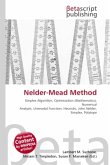High Quality Content by WIKIPEDIA articles! In geometry a polygon (pronounced / p l n/) is traditionally a plane figure that is bounded by a closed path or circuit, composed of a finite sequence of straight line segments (i.e., by a closed polygonal chain). These segments are called its edges or sides, and the points where two edges meet are the polygon's vertices or corners. The interior of the polygon is sometimes called its body. A polygon is a 2-dimensional example of the more general polytope in any number of dimensions. The word "polygon" derives from the Greek ("many") and (g nia), meaning "knee" or "angle". Today a polygon is more usually understood in terms of sides. Usually two edges meeting at a corner are required to form an angle that is not straight (180°); otherwise, the line segments will be considered parts of a single edge. The basic geometrical notion has been adapted in various ways to suit particular purposes. For example in the computer graphics (image generation) field, the term polygon has taken on a slightly altered meaning, more related to the way the shape is stored and manipulated within the computer.
Bitte wählen Sie Ihr Anliegen aus.
Rechnungen
Retourenschein anfordern
Bestellstatus
Storno








